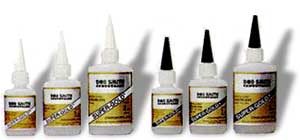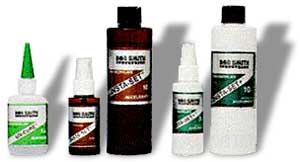Cyanoacrylates

Cyanoacrylates, more commonly known as CA, have become the adhesive of choice for most hobby and household applications. High quality CA’s, when used properly, form bonds that in many cases are stronger than the material that is being adhered.
CA’s are reactive monomers that chemically link (polymerize) when pressed into a thin film. The very thin layer of water moisture present on most surfaces acts as an alkali, or weak base, which is the catalyst that results in bonding; however, the presence of detectable amounts of water usually degrades the performance of CA’s.
With all CA’s, the closer the parts fit together, the stronger the bond. Always hold the bonding surfaces as tightly as possible. Any rough spots on the mating surfaces should be smoothed out. Although CA’s will hold objects together with considerable strength within seconds, the full strength of the bond is not reached for several hours. Allow for this before subjecting parts to maximum stress. Also, CA’s are generally a little less brittle and have higher strength when they are allowed to cure on their own.
Heat and moisture will decrease the shelf life of CA’s. Unopened bottles can be stored in a freezer or refrigerator, but allow them to reach room temperature before using. Keep your bottles in a cool place that won’t be exposed to direct sunlight and store away from bottles of accelerators.

Bob Smith’s Insta-Cure has a water-thin viscosity that wicks deep into joints by capillary action and cures in a matter of a few seconds. Surfaces to be bonded must be tight fitting and should be held together while you apply the CA around the edges of the seam. At the moment CA’s cure, they give off a vapor that can irritate the nose and eyes, so be prepared. Thin CA’s work very well on balsa since they penetrate into the wood and form more than just a surface bond.
Insta-Cure+ is a higher viscosity CA for loose fitting joints in which the adhesive must bridge gaps. Normally, the thicker CA is applied to one surface and then the parts are held tightly together for about 5 to 15 seconds. For large surface areas, including those with close fitting joints such as laminations, Insta-Cure+ should also be used. To prevent premature curing, don’t spread the glue into a thin film. Lay down a serpentine bead with about 1” separations on one surface, then assemble the parts, letting the pressure spread the CA out.
Insta-Set is a catalyst which acts as an accelerator that allows CA’s to quickly cure in thick layers by enhancing the alkaline conditions during polymerization. Insta-Set in a spray bottle is normally used to cure the CA that flows from joints when parts are pressed together. Applying an additional bead of thick CA along a seam and then curing it with Insta-Set significantly enhances a joint’s strength. For difficult to bond materials, Insta-Set is formulated with a strawberry scent and activates CA in 6 to 8 seconds without any degrading of the CA’s strength, which can occur with many other accelerators. It is compatible with all surfaces, even clear plastic and white foam.
Maxi-Cure extra thick CA is the best CA for most plastics, including GE’s Lexan. Maxi-Cure is the best choice for plastic model assembly. When used with Insta-Set, it works better than any putty for modifying of filling voids. It can be carved with a knife or razor blade and sanded and feathered to form a finish indistinguishable from plastic. Maxi-Cure bonds fiberglass, hardwood, metal and rubber better than any other hobby adhesive. For gluing to the inside, cloth textured surface of fiberglass, scrape the area to be bonded with a razor blade or coarse sandpaper before using Maxi-Cure or any other adhesive. It also is best for bonding the tires for R/C cars.
Super-Gold and Super-Gold+ are Bob Smith’s odorless Insta-Cure CA’s. They are non-frosting and take only 2 to 3 seconds longer to bond. There are no fumes that irritate the nose and eyes. The Super-Gold’s do not attack white foam; therefore, they can be used in the building of foam core wings and the assembly and repair of plastic and foam ARF’s. They will not fog clear plastic. Super-Gold+ is ideal for attaching clear canopies in plastic model kits; however, Maxi-Cure is still recommended for assembling the rest of plastic kits. Wood can be bonded to white foam with Super-Gold+ in less than fifteen seconds. For bonding foam to foam, spray a very light fog of Insta-Set to one piece and apply Super-Gold+ to the other before joining. Excess Insta-Set may create too much heat, which can melt the foam. Both Super-Gold’s cure to a more flexible consistency for better shock absorption. Whenever a large amount of CA is to be used in such applications as saturating fiberglass or Kevlar, Super-Gold eliminates the irritating fumes from the evaporating monomer that make repeated use of CA unpleasant at times.
Un-Cure debonder will soften cured CA. If parts are bonded incorrectly or your fingers are stuck together, a few drops of Un-Cure will dissolve the CA in about a minute. Apply on bonded skin and roll apart fingers. Once unstuck, use acetone to clean off softened CA, then wash off with soap and water.
Due to the freshness of Bob Smith CA’s, their shelf life is guaranteed for 24 months.
Text from the Bob Smith Adhesives website.
Epoxies

For stronger bonding, epoxy is the preferred adhesive. High-power rockets should be built entirely with epoxy and even large model rockets should use epoxy for high-stress joints such as the fin-to-body and motor mount joints.
There are many makers of epoxy. Hardware stores and hobby shops sell epoxy in small tubes or bottles which mix together in a 1:1 ratio (one part resin to one part hardener. This epoxy is usually about right for bonding, but too thick for fiberglassing. The maker will probably have a thinner “finish” epoxy which can be used for filling wood and fiberglassing. Hobby shop epoxy is rated by its “handling time,” the amount of time you have before the epoxy starts to set up. The full cure time is generally 8-10 times this long. If you are using 5-minute epoxy, you have five minutes or less to get your fin aligned, but can go on to the next fin in 10-15 minutes, with full cure in 45 minutes. An epoxy with a longer handling time tends to soak into porous surfaces more and thus is stronger. Most people use the 5- and 30-minute types for rocketry work.
Moving beyond the hobby shop epoxy are complete “epoxy systems.” These product lines require buying into the system, but provide a much wider range of mixtures for different purpose and are generally stronger. The most commonly used epoxy system for high-power rocketry is West System. See the West System article for more information. Another popular system is Fibre Glast.
For more information, see the Epoxy Tips article.
Submitted by: John Coker